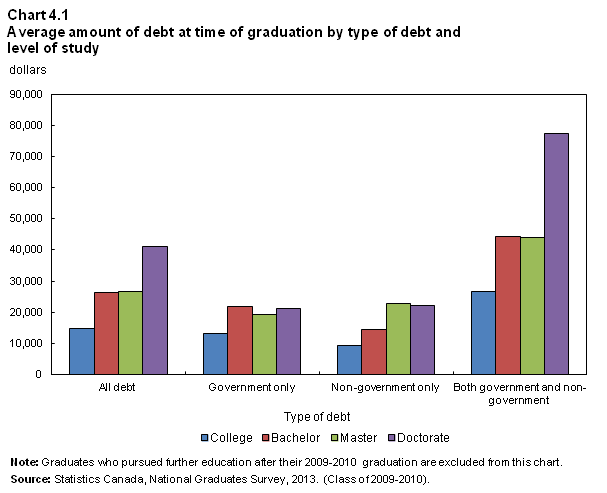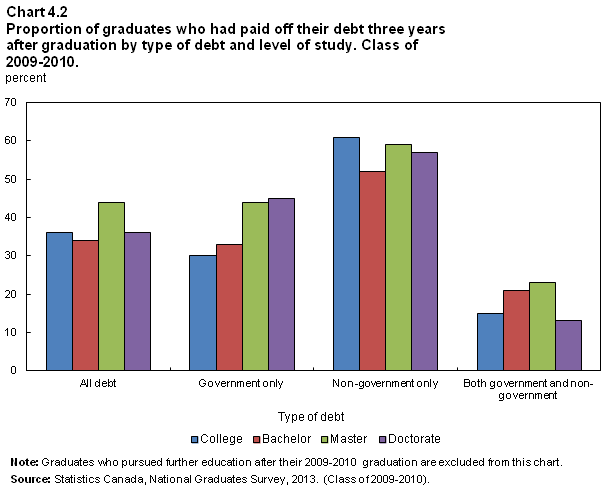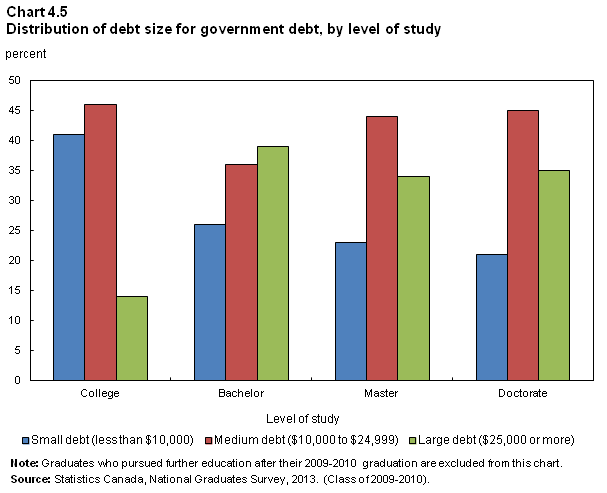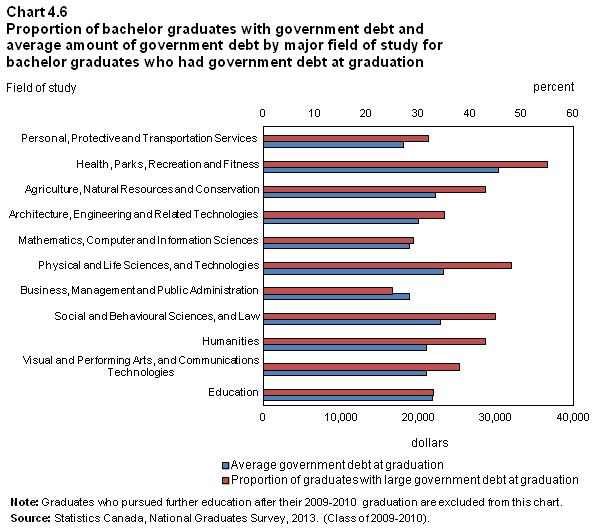Publications
Culture, Tourism and the Centre for Education Statistics: Research Papers
Graduating in Canada: Profile, Labour Market Outcomes and Student Debt of the Class of 2009-2010 - Revised
Section 4
Student loans and debts
Archived Content
Information identified as archived is provided for reference, research or recordkeeping purposes. It is not subject to the Government of Canada Web Standards and has not been altered or updated since it was archived. Please "contact us" to request a format other than those available.
Canadian students in postsecondary education get financial support from a wide variety of sources including employment income, family support, scholarships, grants and loans from government and private sources.
This section looks at student debt incurred by the graduating class of 2009-2010 and examines only graduates who did not pursue further education within the three years after graduation.
The NGS collected information on government student debt and non-government student debt which include money borrowed from banks, family and friends and credit card debt. The analysis begins with an overview of debt incurred by graduates by examining the proportion with debt at the time of graduation, the average amount of debt at graduation, and the proportion of graduates who had paid off their debt within three years of graduation.
Overview of student debt
Less than half of all graduates had some form of student debt upon graduation
Among graduates from the Class of 2009-2010 who did not pursue further education, over 40% financed their postsecondary education with some form of loanNote 12 (Figure 4.1.1 and 4.1.2). This proportion was highest for bachelor graduates at 50% and lowest for doctoral graduates (41%).
In addition to examining the overall debt level, graduates were grouped into the following three categories based on the source of debt: 1) government debt only; 2) non-government debt only; and 3) both government and non-government debt. Figure 4.1.1 and Figure 4.1.2 show the distribution of graduates by level of study according to whether they incurred debt or not, and the source of their debt.


Government student loans were the most common source of debt
As shown in Figure 4.1.1 and figure 4.1.2, government loans were the most common source of debt. Across all levels of education, the proportion of graduates who had debt owing to government only ranged from 18% among doctorate graduates to 25% of bachelor graduates.

Figure 4.2 summarizes the total number of graduates from the Class of 2009-2010 who had student debt by the type of debt that they held. While the majority of graduates held only one source of debt, almost 27,000 graduates held both government and non-government debt at graduation. The use of non-government only and both government and non-government loans to finance education varied by level of study. The same proportions of bachelor and doctorate graduates used both sources of funding to finance their education (14%) which was higher than the proportion of college graduates (9%) and master graduates (11%). On the other hand, a higher proportion of master graduates (14%) used only non-government funding for their education compared to doctorate graduates (9%). The proportion of college and bachelor graduates who used only non-government student funding for their education was similar (13% and 12% respectively).
Doctorate graduates owed almost three times higher than college graduates
As shown in Chart 4.1, when looking at debt owed by graduates to any source, college graduates had the lowest average debt, owing an average of $14,900 at graduation. Bachelor and master graduates reported similar debt levels at graduation ($26,300 and $26,600 respectively) while doctorate graduates report the highest debt, graduating with an average debt of $41,100.

The average amount of debt varied by the type of debt held and level of study. Average debt for college graduates was lowest across all three debt categories (Chart 4.1) while debt for doctorate graduates was highest for most categories. The variation in debt load by education level was least pronounced for graduates owing only to government sources: bachelor graduates had the highest debt ($21,700) and this amount was slightly higher than the average debt for master and doctorate graduates ($19,300 and $21,200 respectively). In contrast, the variation in average debt by education level was larger for those with only non-government student loans and even more pronounced for those with both government and non-government student loans.
Graduates who used both government and non-government loans had more than twice the debt load than students who borrowed from only one source
Although the proportion of graduates with both government and non-government debt was not relatively high, it still represented 26,600 graduates (Figure 4.2). Moreover, graduates with both sources of debt had much higher debt than those who owed only one type of debt. As shown in Chart 4.1, across all levels of education, the debt level of graduates who borrowed from both sources was more than twice as high as those that borrowed from just one source. Additionally, the average debt load was higher than the combined average debt loads of those who had loans from single sources. For example, the average debt of a college graduate who had loans from both sources at graduation ($26,700) was $4,000 more than the average debt of those who had loans from government sources combined with those who had loans from non-government sources at the college level ($13,300 +$9,400=$22,700).
The proportion of graduates who had paid off their debt three years after graduation was highest for master graduates
The proportion of graduates who had paid off their government student loans entirely three years after graduation differed by education level. Although college graduates had lower average debt compared to other graduates (Chart 4.1), only 36% of them paid off their debt to any source, the same as doctorate graduates who incurred much higher debt levels (Chart 4.2). Master graduates were the group with the highest proportion who paid off their debt to any source (44%), while a lower proportion of bachelor graduates (34%) had fully paid off their debt three years after graduation.

More co-op graduates had student debt but the debt level was lower than that for other graduates
As shown in Chart 4.3, a slightly higher proportion of co-op graduates reported owing student debt to any source at the time of graduation: 48% vs. 43% at the college level and 56% vs. 50% at the bachelor level.
On the other hand, graduates from a co-op program reported slightly lower debt than their non-co-op peers. Chart 4.3 shows that, on average, college co-op program graduates owed $14,200 at the time of graduation, while college non-co-op graduates owed $15,300. At the bachelor level, the average debt owed at the time of graduation among co-op graduates and non-co-op graduates were $24,400 and $26,600, respectively.

Graduates with co-op experience were more likely to have paid off their debt three years after graduation
As shown in Chart 4.4, at both college and bachelor levels, a higher proportion of co-op program graduates paid off their debt three years after graduation than their non-co-op program peers (42% vs. 35% and 42% vs. 33%, respectively). At the bachelor level in particular, this may be associated with the higher earnings reported by co-op graduates thus affording them more opportunity to pay off their loans.
However, for those who still had debt outstanding three years after graduation, average debt remaining did not vary much between co-op graduates and non-co-op graduates. At the college level, the average debt remaining three years after graduation was $12,200 for co-op graduates and $12,400 for non-co-op graduates. At the bachelor level, those with co-op experience had $18,600 debt remaining three years after graduation while those without co-op experience had $19,800 remaining.

Government-financed student debt
Given the importance of government loans in financing student education, the remainder of this section focuses on government-financed student debt. It also discusses the amount of this debt and repayment by level of education and field of study. Debt of $25,000 or more was classified as large, as accumulation of debt of this size represents a substantial financial burden for most graduates. Again, this analysis was limited to graduates who have not pursued any further education within three years after graduation in 2009-2010 (and have therefore been required to begin repaying their loans and have not accumulated further student debt).
College graduates had the highest proportion of small debt (under $10,000) while bachelor graduates had the highest proportion of large debt ($25,000 or more)
As shown in Chart 4.5, a higher proportion of college graduates who owed money to government student loans at graduation finished their studies with only small debt (under $10,000) (41%), compared to graduates at the bachelor (26%), master (23%) and doctorate (21%) levels. On the other hand, a higher proportion of bachelor graduates had large debt ($25,000 or more) at graduation (39%), followed by doctorate graduates (35%), master graduates (34%) and finally college graduates (14%). It is worth noting that almost half of graduates at the college, master and doctorate levels had medium debt ($10,000 to $24,999) at graduation (46%, 44% and 45%, respectively) while only 36% of bachelor graduates did.

Table 4.1 shows that graduates with smaller debt loads were more likely to have their debt paid off three years after graduation. This can be observed at all levels of education. Among graduates with small debt (less than $10,000), those at the master level were the most likely to have their debt paid off (67%) while those at the college level were the least likely (48%).
Graduates with large debt loads at all levels of education were the least likely to have their debt paid off three years after graduation. For example, one-quarter (25%) of bachelor graduates with large government loans paid it off three years after graduation compared to over half (53%) of bachelor graduates with small government loans. Moreover, the proportion of graduates with large government debt at graduation who had paid off their debt three years after graduation was highest among master graduates (29%), followed by doctorate graduates (26%) and bachelor graduates (25%).
The proportion of graduates with large government debt varied across fields of study
Chart 4.6 shows the size of average debt at graduation and the distribution of bachelor graduates across fields of study with large debt loads. ‘Health, parks recreation and fitness’– a field that included Medicine – had the highest proportion with large debt loads (55%) and also had the highest average debt loads ($30,400). On the other hand, ‘business, management and public administration' had the lowest proportion with large debt loads (25%).

Within the major field of study ‘health, parks, recreation and fitness’, the size of average government debt at graduation varied by subcategory (Appendix table A.16). For example, graduates from ‘parks, recreation, leisure and fitness studies’ and ‘medicine’ had the lowest ($16,600) and highest average debt ($56,000) at graduation, respectively. Moreover, graduates from ‘medicine’ had the highest proportion who paid off their government student loan three years after graduation (60%), while graduates from ‘agriculture, agricultural operations, and related sciences’ had the lowest proportion of paying off their debt three years after graduation (23%). (Appendix table A.16)
At the college level, the proportion of graduates with large debt ranged from 9% (‘engineering technologies/technicians’) to 32% (‘natural resources and conservation’). The lowest average debt load at graduation was observed among graduates from ‘construction trades’ ($6,200) and the highest load was observed among graduates from ‘humanities’ ($19,200). (Appendix table A.16)
At the master level, the proportion of graduates with large debt ranged from 24% (‘architecture and related technologies’) to 44% (‘health, parks, recreation and fitness’). Graduates from ‘mathematics and statistics’ had the highest average debt load at graduation ($25,500). (Appendix table A.16)
At the doctorate level, the proportion of graduates with large debt ranged from 20% (‘mathematics, computer and information sciences’) to 88% (‘visual and performing arts, and communications technologies’). The highest average debt load was found among those from ‘agriculture, natural resources and conservation’ ($44,500) and the lowest average debt was found among those from ‘business, management and public administration’ ($10,100). (Appendix table A.16)
Debt Service Ratios
While debt size is an important factor in the ability to manage debt, it is also important to consider the relationship between income and debt repayments. For this analysis, debt-servicing ratios were calculated for each graduate using information on reported personal income for 2012 and the total amount of debt paid in 2012. This represents debt payments as a percentage of income, a measure commonly used in determining the extent to which student debt payments represent a burden on an individual (see textbox on interpretation of debt service ratios). To put debt-servicing ratios in context, a number of studies in the literature have used an 8% benchmark to denote a high debt burden (Baum and Schwartz, 2006Note 13). Debt-servicing ratios were ranked in ascending order from which the debt ratio at the 25th percentile, the median, and the 75th percentile was determined.
However, it is worth noting that the debt-servicing ratios calculated in this report may not by themselves indicate debt burden. In some cases, the minimum payment required to service the debt constitutes a relatively high proportion of the debtors income. In other cases, debtors choose to make payments exceeding the minimum payment required and thus pay down their debt at higher rates, or they make lump sum payments from savings, family assistance, or other sources. To fully understand how graduates are managing their student debt, further analysis is required.
Interpretation of debt service ratios
Debt service ratios are crude monetary measures of financial burden – or ability to pay – and are expressed in percentage terms. They are calculated as the ratio of debt payments to earned income during a particular time frame and are interpreted as the percentage of income devoted to debt repayments. Debt service ratios can be high for a number of reasons, which include involuntary low income or voluntary high payments.
While far from conclusive, a number of American studies on student debt burdens have often used 8% as a benchmark: graduates beyond this threshold are thought to have debt that is difficult to manage. In the Canadian context, graduates with trouble managing student debt could utilize the Revision of Terms featureNote 14: it provides the borrower with the flexibility to manage their loan repayment in a way that is responsive to their situation. It can be used as a debt management measure designed to decrease monthly payments – and burden. Conversely, it can be used to pay off debt faster through negotiated increases in loan payments.
This section looks at debt-servicing ratios for graduates who owed government loans at graduation and how the ratios differed by size of debt and level of education. In addition, it compares debt to earnings ratios by field of study.
A quarter of bachelor graduates with large government debt ($25,000 or more) at graduation had debt-servicing ratios at or above 13%
As mentioned earlier, debt-servicing ratios were ranked in ascending order from which the debt ratio at the 25th percentile, the median, and finally the 75th percentile was determined. Bachelor graduates with large debt loads at graduation had the highest debt-servicing ratios at the 75th percentile (13%) compared to graduates from other levels of education (Appendix table A.15). In other words, a quarter of the bachelor graduates with large debt (about 3,800 individuals) spent 13% or more of their income on student debt repayment. This means that after theoretically paying government student debt, 87% of their gross earned income was left for other expenses. Slightly lower proportions were found among master (10%), doctorate (10%) and college graduates (9%) with large government debt. At lower categories of debt, the debt ratios were substantially lower except for college graduates. For example, at the medium debt category ($10,000 to $24,999), the debt service ratio at the 75th percentile was 7% for bachelor graduates (i.e. 25% of bachelor graduates with medium debt had debt-servicing ratios at or above 7%), and 5% for both master and doctorate graduates. For college graduates, however, the debt servicing ratio at the 75th percentile was the highest (10%). At the small debt category (less than $10,000), the debt service ratio at the 75th percentile was the highest among college graduates (5%), followed by bachelor and master graduates (4%) and finally doctorate graduates (1%).
The remaining debt to earnings ratio varied across levels of education and fields of study
The remaining debt to earnings ratios were calculated as the ratio of debt remaining three years after graduation to earned income. In general, the average debt remaining three years after graduation for those who were employed in 2013 was less than the average debt remaining for those who were unemployed (Appendix table A.17). For example, at the bachelor level, among graduates from ‘physical and life sciences and technologies’, the average student debt remaining three years after graduation was $23,000 for those who were employed in 2013 and about $27,800 for those who were unemployed in 2013. The highest remaining debt to earnings ratio was found in ‘biological and biomedical sciences’ (54%) under ‘physical and life sciences, and technologies’ and the lowest debt to earnings ratio was found in ‘medicine’ (15%) under ‘health, parks, recreation and fitness’. At the college level, the highest debt to earnings ratio was found in ‘personal and culinary services’ (35%) under ‘personal, protective and transportation services’ and the lowest was found in ‘construction trades’ (11%) under ‘architecture, engineering and related technologies’.
Summary
Students finance their postsecondary education in different ways. Less than half of the graduates from the Class of 2009-2010 relied on either government or non-government student loans. Moreover, 22% of the graduates owed solely to government sources and 12% of the graduates owed to both government and non-government sources.
College students were more likely to graduate with small debt (under $10,000) while bachelor students were more likely to graduate with large debt ($25,000 or more). The proportion of graduates with large debt varied across fields of study within each level of education. Above half of bachelor graduates (55%) from ‘health, parks, recreation and fitness’ had large debt loads ($25,000 and over) upon graduation while only 25% of graduates from ‘business, management and public administration’ had large debt loads at the time of graduation.
A higher proportion of co-op graduates reported student debt compared to other graduates. However, the average debt at graduation was lower for co-op graduates than for other graduates. Additionally, the proportion of graduates who had paid off their debt three years after graduation was higher for those who had participated in co-operative education.
Graduates with large debt load at all levels of education were the least likely to have their debt paid off three years after graduation. Master graduates were most likely to have their debt paid off. Bachelor graduates with large debt loads at graduation had the highest debt-servicing ratios at the 75th percentile (13%) compared to graduates from other levels of education (10% for master and doctorate graduates and 9% for college graduates). Moreover, the remaining debt to earnings ratio varied across levels of education and fields of study.
Conclusion
This report provides an initial overview of graduates from public postsecondary institutions in Canada in 2009-2010 using data from the 2013 National Graduates Survey (NGS). The NGS provides important information on the outcomes of graduates and how they are contributing to the social and economic fabric of the nation. The Class of 2009-2010 was the first National Graduates Survey cohort after the 2008 economic downturn, which was a time of demographic shifts, economic uncertainty and changes in the labour market emphasizing the need for a highly educated workforce. Graduates were interviewed three years later to measure their various labour market outcomes as well as to gather information on the financing of higher education. This was a different reference period compared with 2005, which interviewed graduates two years after graduation.
A large proportion of both college and bachelor’s graduates had non-linear pathways either by delaying entry to their program from high school or previously pursuing postsecondary education prior to the program from which they graduated in 2009-2010. Additionally, a large proportion of graduates in 2009-2010 pursued further education after graduation. Bachelor graduates were the most likely to have pursued further education, at 49%, followed by college graduates (35%), master graduates (32%) and earned doctorate graduates (16%).
Among those who did not pursue further education after graduation, most graduates at each level of education enjoyed high employment rates, ranging from 90% among college graduates to 93% among doctorates. The majority of graduates also reported that their job matched their education; however this proportion was lower for college (81%) and bachelor (80%) graduates compared with master (92%) and doctorate (96%) graduates.
Less than half of the graduates from the Class of 2009-2010 relied on either government or non-government student loans. Government student loans were the most common source of debt and over one-third of graduates owed to government sources. In terms of size, college graduates had the highest proportion of small government debt while bachelor graduates had the highest proportion of large government debt, this also varied by field of study. The proportion of graduates who had paid off their government debt three years after graduation was the highest for master graduates.
The NGS showed that those who participated in co-op education programs benefited in the labour market. Among those who did not pursue further education, both college and bachelor graduates of a co-op program had higher employment rates than those who did not participate in a co-op program. And at the bachelor level, graduates with co-operative work experience had higher earnings than other graduates. A higher proportion of co-op graduates had student debt but the debt level was lower than that for their non-co-op peers. Moreover, co-op graduates were more likely to have paid off their debt three years after graduation.
Future research should build on this report by looking more in depth at differences in labour market outcomes and job quality measures of graduates by their diverse education pathways.
Notes
- Date modified:
